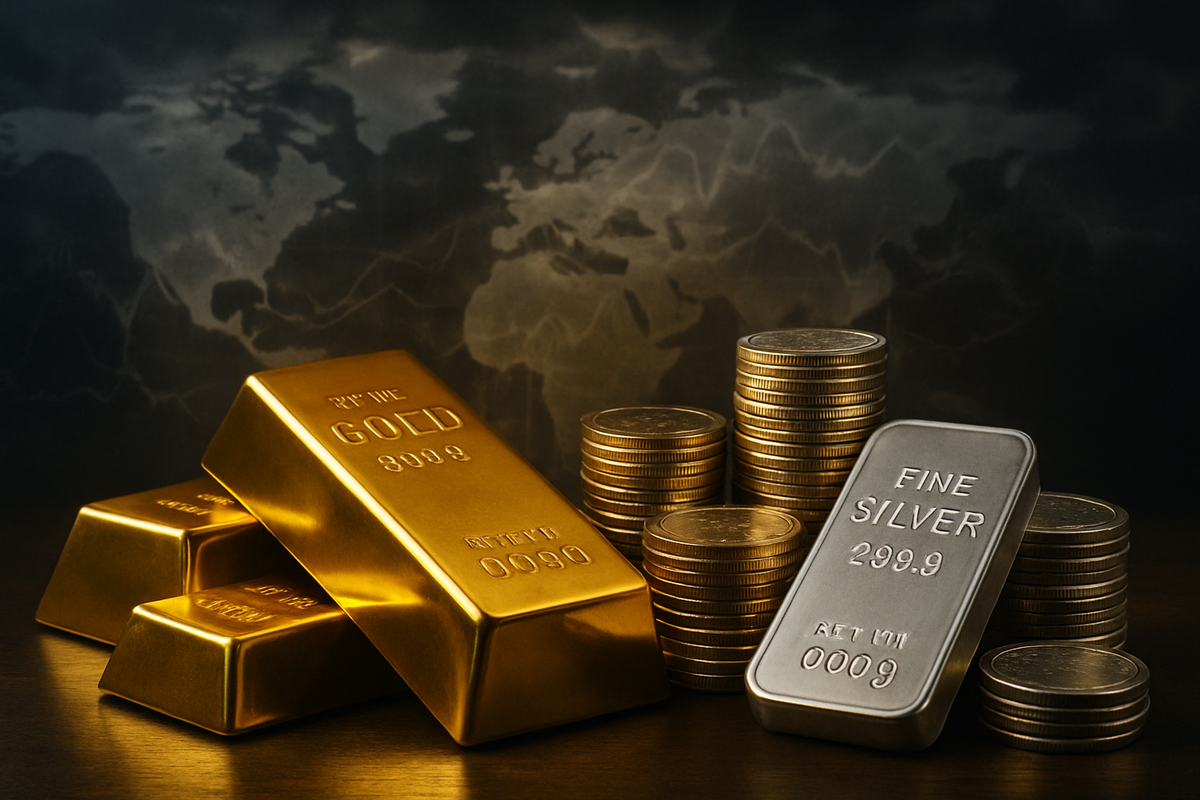Financial News
Gold and Silver Soar to Unprecedented Heights Amidst Global Turmoil and Economic Shifts

As of October 13, 2025, the precious metals market is witnessing a historic rally, with both gold and silver shattering previous records to reach unprecedented price levels. Gold has surged past the formidable $4,000 per ounce mark, even touching $4,101.05, representing an astonishing nearly 100% appreciation since early 2024. Silver's ascent has been equally dramatic, with a staggering 70% increase year-to-date in 2025, surpassing its 1980 record to hit an unprecedented $51.71 per ounce. This monumental rally signals a profound shift in global investor sentiment, reflecting deep-seated anxieties over economic stability, geopolitical tensions, and the long-term outlook for traditional financial assets.
The immediate implications of this surge are far-reaching, signaling sustained market volatility and a growing distrust in fiat currencies and conventional financial systems. Investors are increasingly flocking to hard assets as a reliable store of value amidst a landscape of persistent inflation, weakening U.S. dollar, and escalating global conflicts. The rally underscores a broader re-evaluation of investment paradigms, with tangible assets like gold and silver asserting their traditional role as safe havens in turbulent times.
Unpacking the Historic Rally: A Confluence of Factors
The remarkable performance of gold and silver is the culmination of a complex interplay of economic indicators, intensified geopolitical events, and a significant re-calibration of investor sentiment throughout 2024 and into 2025. The timeline leading up to this moment reveals a steady build-up of pressures that have collectively propelled precious metals into uncharted territory.
Economically, persistently high inflation rates across major economies have been a primary catalyst. With core inflation remaining stubbornly above target (e.g., 3.3% year-over-year through September 2024), investors have sought refuge in gold and silver to hedge against the erosion of purchasing power. This inflationary environment has been exacerbated by record-high U.S. national debt, exceeding $37 trillion by October 2025, fueling concerns about financial stability and potential currency debasement. Adding to this, the U.S. Federal Reserve's anticipated interest rate cuts, initiated with a 50 basis point reduction in September 2024, have significantly reduced the opportunity cost of holding non-yielding assets, making gold and silver more attractive. The concurrent weakening of the U.S. dollar index by nearly 10% in 2025 has further diminished its appeal as a safe-haven, redirecting capital towards precious metals. Silver, in particular, has seen its industrial demand surge, driven by its critical role in green energy technologies like solar panels (16% of global demand) and electric vehicles (2.9% of global demand), creating a powerful demand-side push beyond its monetary appeal.
Geopolitical instability has played an equally crucial role. Renewed and aggressive trade hostilities between the U.S. and China, including new U.S. tariffs and China's expanded export controls on critical rare earth elements, have intensified fears of a global economic showdown. Persistent conflicts, such as the ongoing Russia-Ukraine war and tensions in the Middle East, continue to shake global financial stability, compelling investors to seek secure assets. Furthermore, a growing de-dollarization movement, with central banks in emerging markets like China and India accelerating gold accumulation to diversify reserves, provides a structural floor beneath gold prices. Key players in this scenario include the world's central banks, major institutional investors, and individual retail investors, all contributing to the unprecedented demand. Initial market reactions have been characterized by heightened volatility across asset classes, with a notable rotation of capital out of riskier assets and into the perceived safety of precious metals. The London silver market, in particular, has reportedly experienced a severe liquidity crisis and a historic "short squeeze," dramatically propelling spot prices.
Winners and Losers in the Precious Metals Boom
The historic surge in gold and silver prices creates a distinct landscape of winners and losers across various industries, fundamentally altering the financial outlook for many public companies.
Unsurprisingly, precious metals mining companies stand to be the most significant beneficiaries. Miners like Barrick Gold Corp. (NYSE: GOLD) and Newmont Corporation (NYSE: NEM) for gold, and Pan American Silver Corp. (NASDAQ: PAAS) and Fresnillo PLC (LSE: FRES) for silver, will see substantial increases in their revenues and profit margins. Higher commodity prices directly translate to more profitable operations, allowing these companies to potentially expand exploration efforts, invest in new technologies, or return capital to shareholders through dividends and buybacks. However, they must also contend with rising production costs and the need for efficient capital allocation to truly capitalize on this boom. Companies with lower all-in sustaining costs (AISC) will be particularly well-positioned to maximize their gains.
Conversely, industries heavily reliant on silver as an industrial input face significant headwinds. Manufacturers of solar panels, electric vehicles, and electronics will grapple with escalating raw material costs. Companies like First Solar, Inc. (NASDAQ: FSLR), a leading solar panel manufacturer, or major automotive players incorporating silver into EV components, may see their production costs rise, potentially squeezing margins or forcing them to pass costs onto consumers. This could lead to a search for alternative materials or a slowdown in production if the cost burden becomes too high. The jewelry industry, while also using gold and silver, might see a mixed impact. While the intrinsic value of their products increases, higher prices could deter some consumers, especially for discretionary purchases. Retailers like Tiffany & Co. (NYSE: TIF, now part of LVMH Moët Hennessy Louis Vuitton) might experience shifts in consumer demand patterns, with a potential lean towards higher-end, investment-grade pieces.
Furthermore, financial institutions offering precious metal ETFs and other investment products, such as BlackRock, Inc. (NYSE: BLK) with its iShares Gold Trust (NYSEARCA: IAU) and iShares Silver Trust (NYSEARCA: SLV), are likely to see increased inflows and asset under management, boosting their fee income. However, banks with significant exposure to short positions in silver or those that have underestimated the market's trajectory could face substantial losses, as evidenced by reports of a historic short squeeze in the London silver market. The broader financial sector will also need to adapt to increased volatility and potentially revised hedging strategies as the value of these key commodities continues to fluctuate dramatically.
Wider Significance: A Shift in Global Financial Tides
The record-breaking surge in gold and silver prices transcends mere market movements; it signifies a profound shift in global financial tides, reflecting deeper economic and geopolitical anxieties that are reshaping investment strategies and international relations. This event is not an isolated incident but rather a symptom of broader industry trends pointing towards a re-evaluation of risk and value in an increasingly uncertain world.
The rally strongly underscores the persistent inflationary pressures that have plagued global economies, making precious metals an indispensable hedge against currency debasement. It also highlights a growing skepticism towards the efficacy of traditional monetary policies, particularly the long-term impact of quantitative easing and escalating national debts. The de-dollarization movement, where central banks globally are actively diversifying their reserves away from the U.S. dollar by accumulating gold, is gaining significant momentum. This trend, driven by geopolitical considerations and a desire for financial sovereignty, could have ripple effects on the U.S. dollar's status as the world's primary reserve currency, impacting global trade and finance.
Historically, gold and silver have served as safe havens during times of crisis. This current surge draws parallels to periods of high inflation in the 1970s and the aftermath of the 2008 financial crisis, where precious metals experienced significant rallies. However, the current environment is unique due to the simultaneous confluence of high inflation, aggressive central bank gold buying, unprecedented national debts, and pervasive geopolitical conflicts. Regulatory bodies might face increased pressure to monitor and potentially intervene in precious metals markets, especially in light of reported short squeezes and liquidity issues in markets like London silver, to ensure market stability and prevent excessive speculation. The event also puts a spotlight on the supply chain vulnerabilities for industrial metals like silver, potentially spurring innovation in material science to find substitutes or improve recycling capabilities.
The ripple effects extend to competitors and partners across various sectors. For instance, the increased cost of silver could accelerate the adoption of new, more efficient solar panel technologies that use less silver, or push manufacturers to explore alternative materials, impacting companies across the renewable energy supply chain. Furthermore, the perceived safety of precious metals could divert investment away from other asset classes, including equities and even cryptocurrencies, as investors prioritize wealth preservation over speculative growth in the current climate.
What Comes Next: Navigating the New Normal
The unprecedented rally in gold and silver prices ushers in a new era for financial markets, presenting both significant opportunities and formidable challenges in the short and long term. Investors and industries alike must adapt to this "new normal" where precious metals play an even more central role in global financial strategies.
In the short term, continued volatility is almost a certainty. While the underlying drivers of the rally—persistent inflation, geopolitical instability, and central bank buying—remain strong, technical indicators suggest that both gold and silver are currently in "overbought" territory. This could lead to periods of profit-taking, consolidation, or even sharp corrections as the market digests the rapid gains. However, any dips are likely to be met with strong buying interest, given the structural support for higher prices. Market participants should closely monitor central bank communications regarding interest rate policies, as any deviation from anticipated cuts could temporarily impact sentiment. Geopolitical developments, particularly concerning U.S.-China relations and ongoing conflicts, will also be critical catalysts.
Looking further ahead, the long-term outlook for gold and silver appears robust. The de-dollarization trend is unlikely to reverse course quickly, ensuring continued central bank demand for gold. Silver's dual role as a monetary asset and a critical industrial metal, particularly in the burgeoning green energy sector, provides a strong foundation for sustained demand. This could lead to further strategic pivots across industries, with mining companies potentially increasing capital expenditure on exploration and development, and industrial users investing in R&D for material efficiency or substitution. New market opportunities may emerge in derivatives markets for precious metals, as investors seek sophisticated ways to hedge against price fluctuations or gain leveraged exposure.
Potential scenarios range from a continued, albeit more gradual, ascent for both metals, driven by sustained economic uncertainty and geopolitical tensions, to periods of significant corrections if global stability unexpectedly improves or if central banks adopt more hawkish stances than currently anticipated. However, the prevailing sentiment suggests that the factors that propelled this rally are deeply entrenched. Investors should prepare for a market where precious metals are not just a fringe investment but a core component of diversified portfolios, offering a crucial hedge against systemic risks. The market challenges include managing increased price risk, potential supply chain disruptions for industrial users, and navigating a complex regulatory landscape that may evolve in response to market dynamics.
Comprehensive Wrap-up: A New Dawn for Precious Metals
The historic surge of gold and silver to record highs as of October 13, 2025, marks a pivotal moment in financial history, underscoring a fundamental shift in global economic and geopolitical landscapes. The key takeaways from this event are clear: precious metals have firmly reasserted their role as indispensable safe-haven assets amidst persistent inflation, a weakening U.S. dollar, escalating national debts, and an increasingly volatile geopolitical environment. The concerted efforts of central banks to diversify reserves away from the U.S. dollar further cement the long-term structural support for gold, while silver benefits from both its monetary appeal and critical industrial demand, particularly in the green energy transition.
Moving forward, the market is poised for continued dynamism. While short-term volatility and potential corrections are to be expected as prices consolidate, the underlying drivers suggest a sustained upward trajectory for both metals. The rally reflects a broader distrust in traditional financial systems and a growing global quest for tangible wealth preservation. This sentiment is unlikely to dissipate quickly, making gold and silver central to investment conversations for the foreseeable future.
Investors should closely watch several key indicators in the coming months: central bank monetary policy decisions, particularly from the U.S. Federal Reserve; the evolution of U.S.-China trade relations and other significant geopolitical flashpoints; and the trajectory of global inflation rates. The performance of the U.S. dollar will also remain a critical factor influencing precious metal prices. For those seeking to preserve wealth and hedge against systemic risks, gold and silver are no longer just an alternative but a foundational component of a resilient investment strategy. Their record-breaking performance signals not just a market event, but a profound reordering of financial priorities in a world grappling with unprecedented uncertainty and change.
This content is intended for informational purposes only and is not financial advice
More News
View More





Quotes delayed at least 20 minutes.
By accessing this page, you agree to the following
Privacy Policy and Terms Of Service.



